Designing your dream kitchen involves more than just picking out countertops and cabinets. The electrical elements and choice of appliances play a vital role in creating a functional and enjoyable space.
Let There Be Light: Kitchen Lighting
Lighting is a critical aspect of any kitchen design. It not only enhances functionality but also sets the mood. Here’s what you need to consider when planning your kitchen lighting:
Effective Lighting for Functionality and Atmosphere
In the kitchen, lighting serves two primary purposes: functionality and atmosphere. Task lighting provides clarity for activities like food preparation, while ambient lighting creates a cozy atmosphere. In open-plan designs, mood lighting becomes particularly important.
Dimmer Switches for Versatility
Consider installing dimmer switches for mood lighting in an open-plan kitchen. These switches allow you to adjust the light intensity, creating the perfect ambiance as the day transitions into evening. Dimmer switches are especially valuable when winding down and preparing for bedtime.
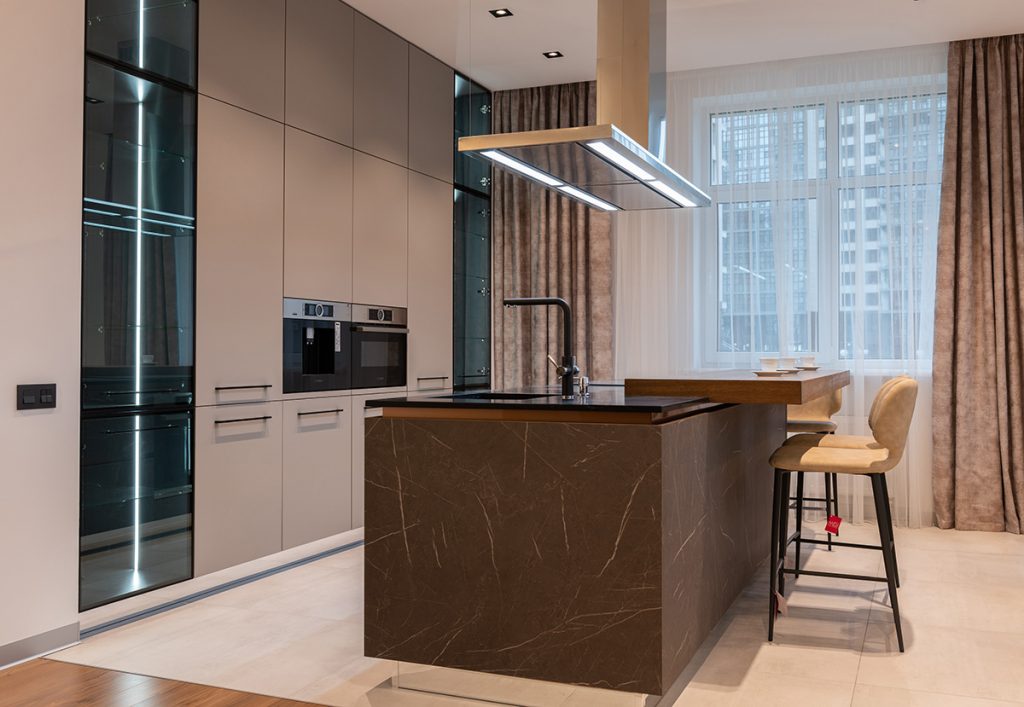
Creating Natural Light Illusion
If your kitchen is located in a darker part of your home, you can simulate natural light by strategically placing fluorescent or LED tubes over cupboards. This light will reflect off a ceiling painted with light-reflective paint, providing indirect illumination. For a stylish conversation piece, consider suspending a lightbox from the ceiling.
Undercounter and Inbuilt Lighting
Modern kitchen designs often incorporate undercounter and inbuilt lighting features. These can include lights inside glass-door cabinets, integrated lighting on the splashback, and undercounter strip lighting. The cost of these lighting elements can vary depending on the extent and quantity of lights designed.
LED Strips for Task Lighting
For shelving and deep drawers, consider adding LED strips. These provide task lighting and make it easier to find items. Additionally, lights in kickers and pelmets can add both style and functionality.
Directional Lights for Flexibility
Directional lights offer flexibility, allowing you to orient them to focus on specific areas. This feature becomes handy after the kitchen installation when you want to adjust the lighting to suit your needs. Pairs of directional LED downlights, for example, can brighten up the kitchen island and cover all angles.
Consider Electrical Costs
Remember that the power supply and connection of these lights may require additional electrical work, which is typically handled by your electrician. Keep in mind that any sound system installations will also add to the electrical costs. Plumbing costs, such as connecting to waste pipes and water connections, should also be factored in.
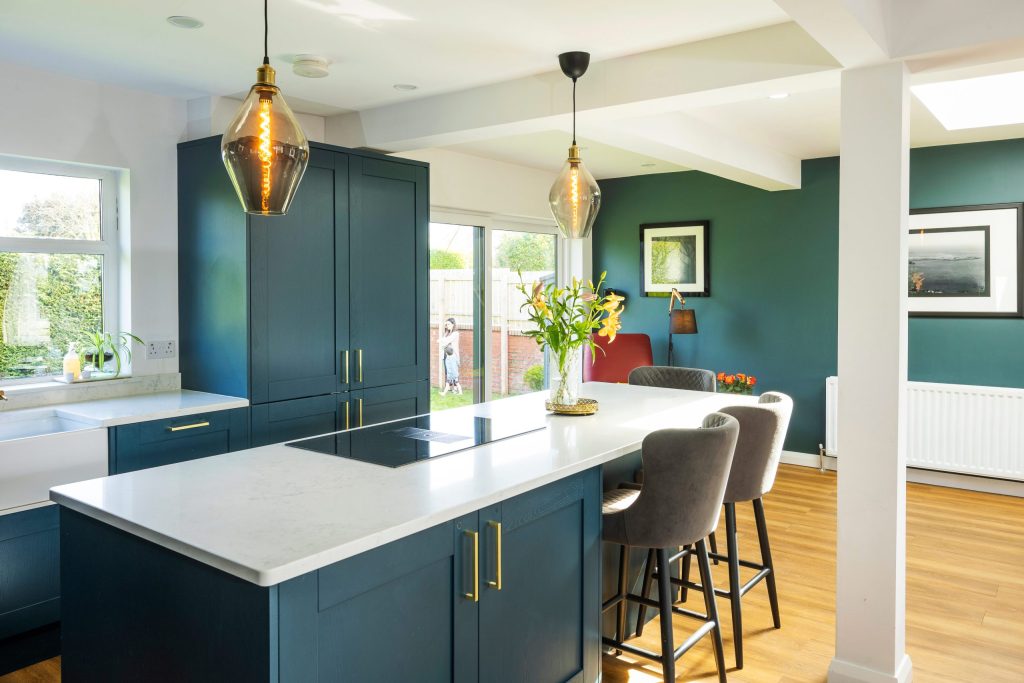
Kitchen Appliances: Choose Wisely
Kitchen appliances are essential components that can significantly impact your kitchen’s functionality and budget. Here’s what you need to consider when choosing your kitchen appliances:
Research and Shop Early
Appliances, including the fridge, oven, cooker, microwave, and coffee maker, can be a substantial portion of your budget, totaling over €5,000. Begin your research on electrical appliances early in your kitchen planning process. This allows you to shop around for bargains, provide accurate measurements to your kitchen manufacturer, and coordinate delivery with fitters well in advance.
Avoid Panicked Decisions
Planning ahead helps you avoid rushed decisions in a busy showroom. It’s easy to make mistakes when you’re overwhelmed with choices. For instance, you might realise that what you thought was a need for a range was actually a hob. Careful planning prevents these costly errors.
Consider Space and Budget Impact
Remember that your appliance choices not only affect your budget but also influence the dimensions of your kitchen, including wall lengths and the overall feel of the space. Therefore, choose appliances that align with your design goals and budget constraints.
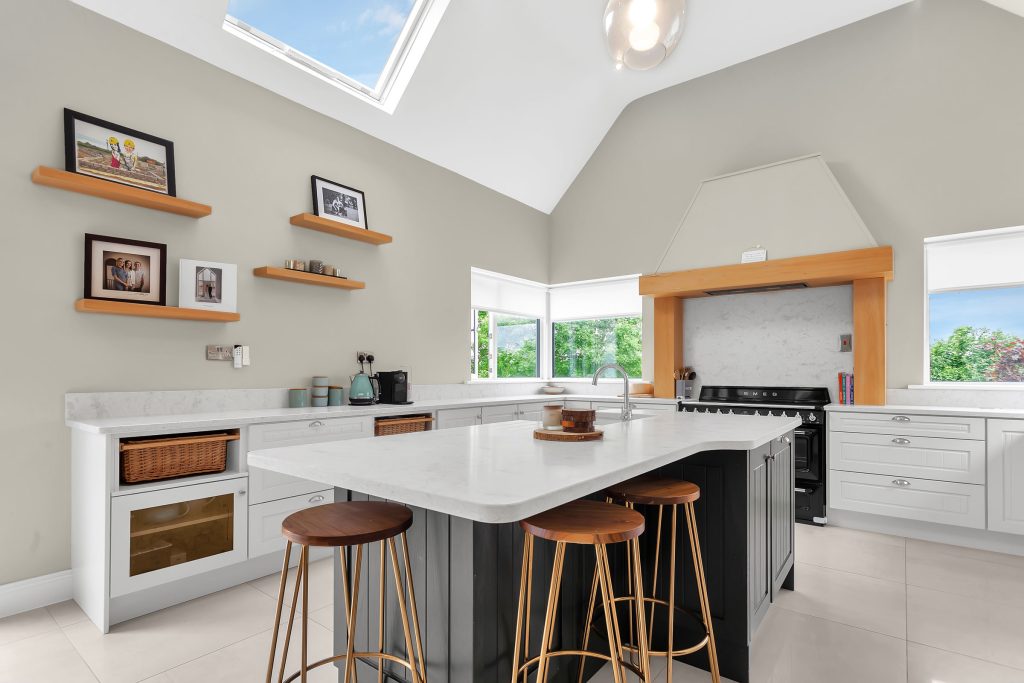
Prioritise Energy Efficiency
All appliances come with ratings for water and energy efficiency. It’s important to consider these ratings before making your purchases. Opting for energy-efficient appliances can result in long-term cost savings and a reduced environmental impact.
Ovens: Comfort and Efficiency
When selecting ovens, consider factors like your physical comfort. If you have back problems, set both the oven and hob at a comfortable height. Multiple ovens and timers can be helpful for family meals. Plate-warming ovens are convenient additions.
Smart Ovens for Precision
Smart ovens offer precise cooking control. They help you time your cooking to perfection, ensuring your dishes are cooked just right. Some smart ovens even feature a residual heat function, where the oven safely switches off once it determines that there is enough heat left to finish cooking.
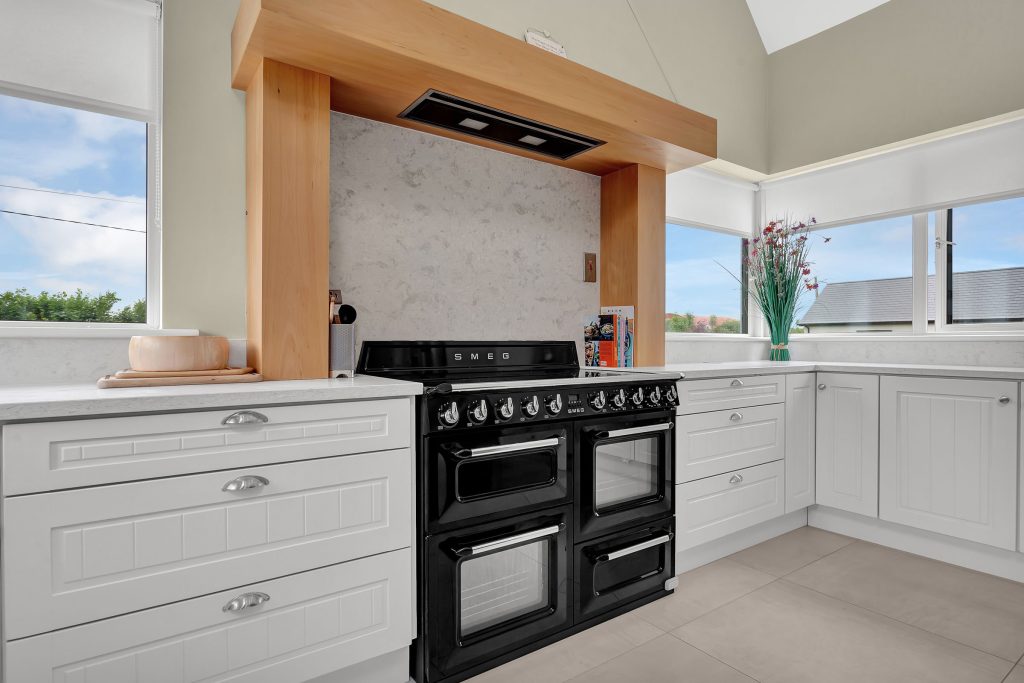
Refrigerators: Size Matters
When choosing a refrigerator, capacity is a critical factor. American fridges, while visually appealing, can be large and freestanding. Check the dimensions of the model you like, as sizes can vary significantly. Additionally, American fridges often have limited interior space due to built-in ice makers and water dispensers.
Fridge vs. Freezer Configuration
Consider your shopping and cooking habits when deciding between a fridge, a freezer, or a combination of both. If you predominantly use fresh ingredients and rarely rely on frozen items, a double fridge may be more suitable than a fridge-freezer configuration.
Handy Undercounter Freezers
Undercounter freezers are practical for those who frequently use specific frozen items. They can be easily replaced with a drinks fridge when dietary requirements change. Keep in mind that you should avoid placing your fridge on top of underfloor heating, and it’s a good practice not to position the oven right next to the fridge. Your kitchen designer can offer advice on ventilation and insulation.
Other Appliances: Dishwashers, Coffee Makers, and More
Dishwashers, though standard in size (typically 600mm wide and deep), come with various internal configurations and wash settings. Some models offer more compact sizes, such as 450mm x 600mm, for limited space.
Coffee makers and wine coolers are increasingly integrated into kitchen designs. These appliances add convenience and style to your kitchen.
Integrated Appliances: A Seamless Look
Integrated appliances are concealed within cabinets and covered with kitchen doors to blend seamlessly into the overall design. This design choice is common in modern kitchens. Keep in mind that integrated appliances require you to purchase matching cabinet doors, and they generally come at a higher price point than standard prefinished appliances.
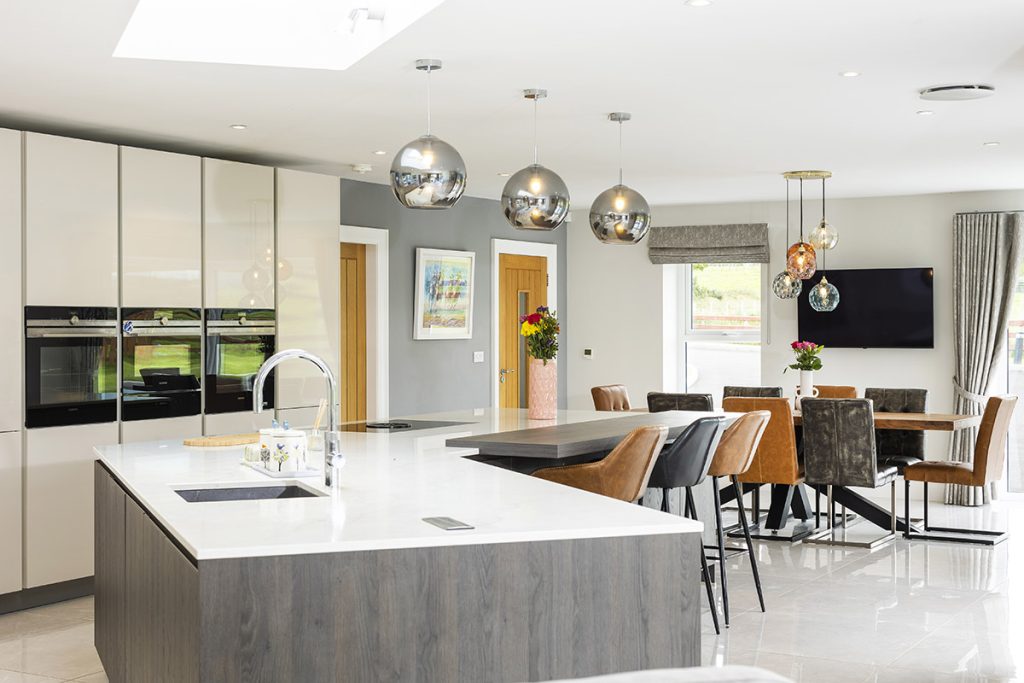
Sockets: A Functional Choice
Sockets are a practical necessity in the kitchen. Consider these options to enhance functionality:
- USB Sockets: These are ideal for charging phones and devices around the kitchen, especially near the island area.
- Wireless Charging Points: For added convenience, you can opt for wireless charging points.
- Popup Sockets: These provide the flexibility to hide sockets when not in use, keeping your kitchen sleek and clutter-free.
- Concealed Sockets: Sockets can also be hidden inside cabinets, drawers, or behind larder doors. However, consult with your electrician to ensure compliance with safety rules, especially around water and unventilated spaces.
- Wall-Mounted Sockets: While common, wall-mounted sockets may affect the visual aesthetics of your kitchen and require additional work, such as cutting wall coverings or slabs, which can add to the overall cost.
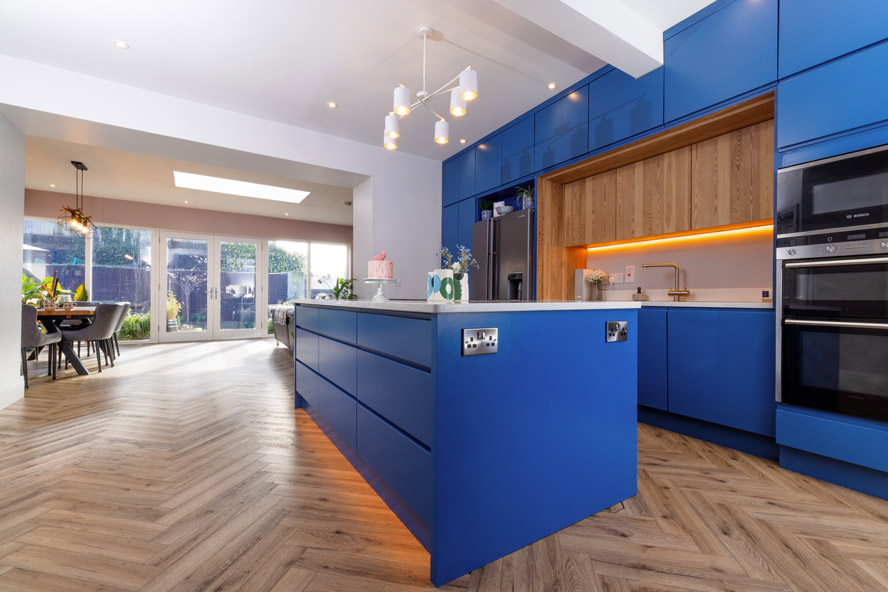
Crafting the Perfect Kitchen
Creating the perfect kitchen involves careful consideration of both the functional and aesthetic aspects of your space. By paying attention to the details of kitchen electrics and appliances, you can ensure that your kitchen not only looks stunning but also serves your needs efficiently. Let’s recap the key takeaways to guide you in your kitchen design journey:
- Effective Lighting: Lighting is crucial for functionality and atmosphere. Task lighting, ambient lighting, and dimmer switches can transform your kitchen into a versatile and inviting space.
- Appliance Research: Start your research early to choose the right appliances that fit your budget and space. Avoid rushed decisions and prioritise energy-efficient options.
- Ovens: Consider the comfort and efficiency of your oven. Smart ovens offer precise control, while innovative features can make cooking safer and more convenient.
- Refrigerators: Size matters when selecting a refrigerator. Think about your shopping and cooking habits to determine whether a fridge, freezer, or combination suits your needs.
- Integrated Appliances: Integrated appliances provide a seamless look in modern kitchens but require careful planning and additional costs for matching cabinet doors.
- Sockets: Plan your electrical sockets wisely, including USB sockets for device charging and innovative options like wireless charging points and popup sockets. Consult with your electrician to ensure compliance with safety regulations.
By taking these considerations into account and planning your kitchen electrics and appliances thoughtfully, you can create a kitchen that not only meets your daily needs but also adds value to your home. Craft the perfect kitchen that brings joy and functionality to your daily life.




